A schooner is a type of sailing vessel with fore-and-aft sails on two or more masts. The most common type has two masts, the foremast being shorter than the main. While the schooner was originally gaff-rigged, modern schooners typically carry a Bermuda rig.
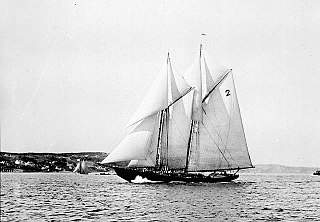
Bluenose was a fishing and racing gaff rig schooner built in 1921 in Nova Scotia, Canada. A celebrated racing ship and fishing vessel, Bluenose under the command of Angus Walters became a provincial icon for Nova Scotia and an important Canadian symbol in the 1930s, serving as a working vessel until she was wrecked in 1946. Nicknamed the "Queen of the North Atlantic", she was later commemorated by a replica, Bluenose II, built in 1963. The name Bluenose originated as a nickname for Nova Scotians from as early as the late 18th century.
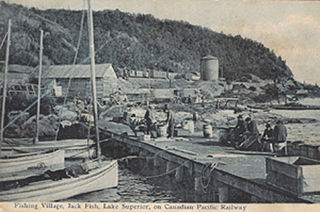
Jackfish is a ghost town in northern Ontario, Canada, located on the north shore of Lake Superior east of Terrace Bay.
Babson Ledge is a small barren rock within the edge of the Western Harbor and Gloucester Harbor in Gloucester, Massachusetts. The rock is situated south of the Fort Point, Pavilion Beach, Blynman Canal, Route 127, and west of Rocky Neck.
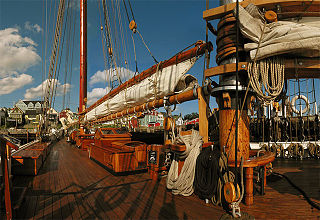
Bluenose II is a replica of the fishing schooner Bluenose, was commissioned by Sidney Culverwell Oland and built in 1963 as a promotional yacht for Oland Brewery. Sidney Oland donated the schooner to Nova Scotia in 1971 and it became Nova Scotia's sailing ambassador.

SS Explorer is one of the last surviving sea-going steam trawlers and is registered to Leith, the port of Edinburgh. She has been placed on the National Historic Ships Register and the SS Explorer Preservation Society is currently restoring her in the Edinburgh Dock, Leith.

Effie M. Morrissey was a schooner skippered by Robert Bartlett that made many scientific expeditions to the Arctic, sponsored by American museums, the Explorers Club and the National Geographic Society. She also helped survey the Arctic for the United States Government during World War II. She is currently designated by the United States Department of the Interior as a National Historic Landmark as part of the New Bedford Whaling National Historical Park. She is the State Ship of Massachusetts.

Adventure is a gaff rigged knockabout schooner. She was built in Essex, Massachusetts, and launched in 1926 to work the Grand Banks fishing grounds near Gloucester. She is one of only two surviving Grand Banks knockabouts – schooners designed without bowsprits for the safety of her crew.
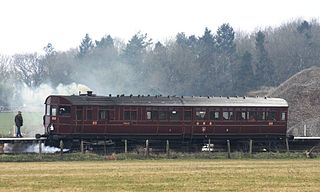
The steam rail motors (SRM) were self-propelled carriages operated by the Great Western Railway in England and Wales from 1903 to 1935. They incorporated a steam locomotive within the body of the carriage.
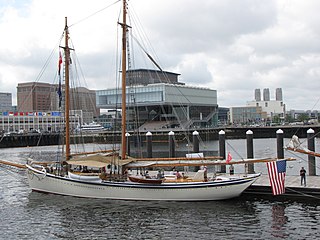
The American Eagle, originally Andrew and Rosalie, is a two-masted schooner serving the tourist trade out of Rockland, Maine. Launched in 1930 at Gloucester, Massachusetts, she was the last auxiliary schooner to be built in that port, and one of Gloucester's last sail-powered fishing vessels. A National Historic Landmark, she is also the oldest known surviving vessel of the type, which was supplanted not long afterward by modern trawlers.

The King and Winge Shipbuilding Company was an important maritime concern in the early 1900s on Puget Sound. The shipyard was located at West Seattle. The owners were Thomas J. King (1843–1925) and Albert M Winge. King was born in Boston and learned to build ships under the famous Donald McKay. He came to Puget Sound in about 1880, and worked in the shipyards of Hall Bros. and T.W. Lake before starting his own shipyard with Winge. King’s partner, Albert L. Winge was a native of Norway.
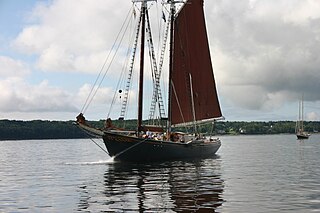
Roseway is a wooden gaff-rigged schooner launched on 24 November 1925 in Essex, Massachusetts. She is currently operated by World Ocean School, a non-profit educational organization based in Camden, Maine, and is normally operated out of Boston, Massachusetts and Saint Croix, U.S. Virgin Islands. She was designated a National Historic Landmark in 1997 as the only known surviving example of a fishing schooner built specifically with racing competition as an objective.
Alabama is a Gloucester fishing schooner that was built in 1926 and served as the pilot boat for Mobile, Alabama. The Alabama's home port is Vineyard Haven, Martha's Vineyard, Massachusetts. The Alabama is owned by The Black Dog Tall Ships, along with the Shenandoah, and offers cruises of Nantucket Sound.

George Lawley & Son was a shipbuilding firm operating in Massachusetts from 1866 to 1945. It began in Scituate, then moved to Boston. After founder George Lawley (1823–1915) retired in 1890, his son, grandson and great-grandson upheld the business, which continued until 1945. Of the hundreds of ships built by the Lawleys, highlights include the yachts Puritan and Mayflower, respective winners of the 1885 and 1886 America's Cup.
The Dartmouth Marine Slips was an historic shipyard and marine railway which operated in Dartmouth, Nova Scotia between 1859 and 2003. It was noted for important wartime work during the American Civil War as well as during the Battle of the Atlantic in World War II. After its closure, the site began redevelopment as King's Wharf, a high-rise residential development.

The Essex Shipbuilding Museum is a maritime museum in Essex, Massachusetts which contains historical and demonstrative displays regarding the history of the wooden shipbuilding industry in Essex. Essex produced more wooden fishing schooners between 1668 and the twentieth century than anywhere else in America. The museum contains various ship models and half hulls including several on display from the Smithsonian Institution. Displays include antique shipbuilding tools, photos, and dioramas of the former shipyard.

Rocky Neck is one of the oldest continuously operating art colonies in the United States. Located on a rocky peninsula within Gloucester's working harbor, Rocky Neck is known for its quaint neighborhood and many art galleries and studios.

Jean Street Shipyard is a shipyard in the United States, located on the Hillsborough River in Tampa, Florida. It is located approximately 5 miles from the mouth of the Hillsborough River, about 1 mile above the Hillsborough Avenue bridge in what is now the neighborhood of Seminole Heights. It is a full service shipyard with wet slips and a Travelift for hauling vessels from the water.
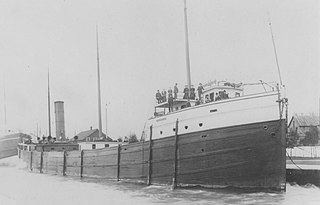
The Iosco was a Great Lakes freighter that served on the Great Lakes from her construction in 1891 to her foundering on September 2, 1905, when she and her tow, the schooner barge Olive Jeanette sank on Lake Superior. While the Jeanette's wreck was located in over 300 feet (91 m) of water about eight miles (13 km) off the Huron Islands in the 90s, the Iosco's wreck has not yet been found.
















